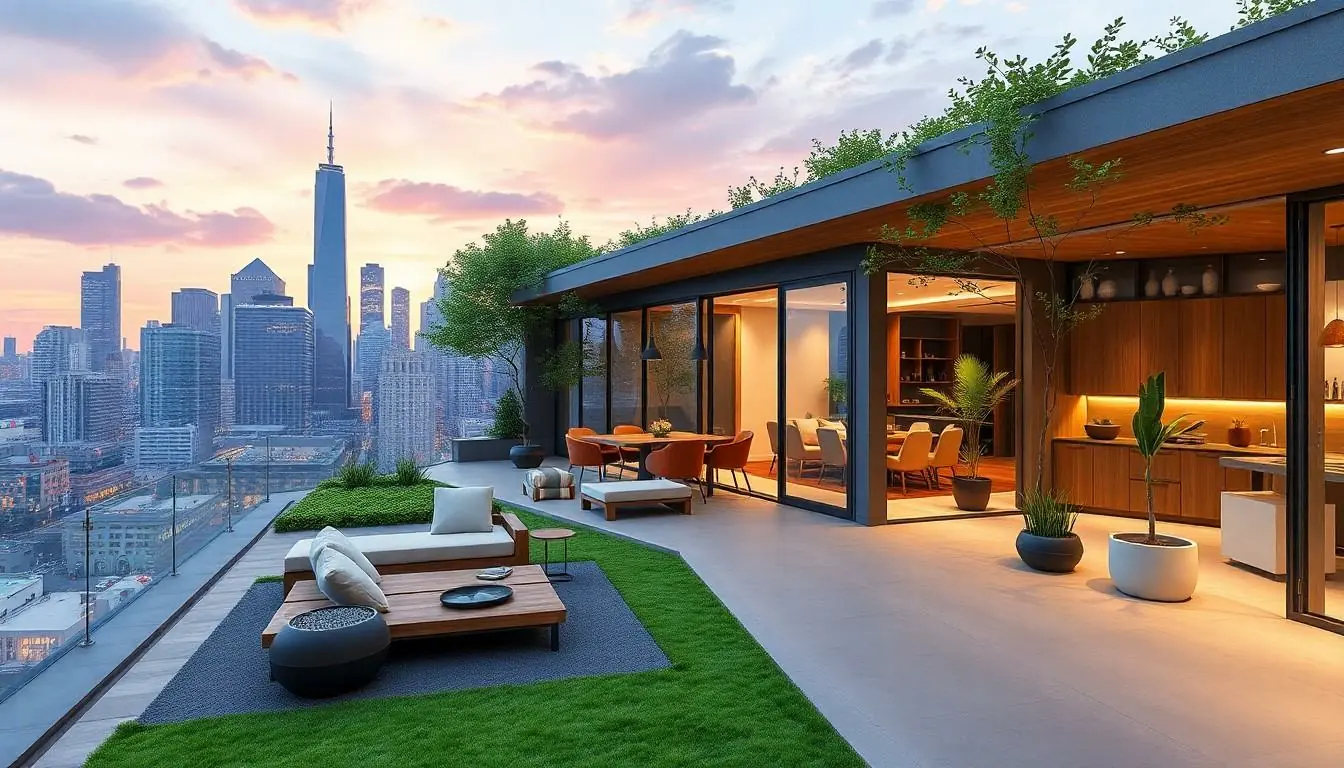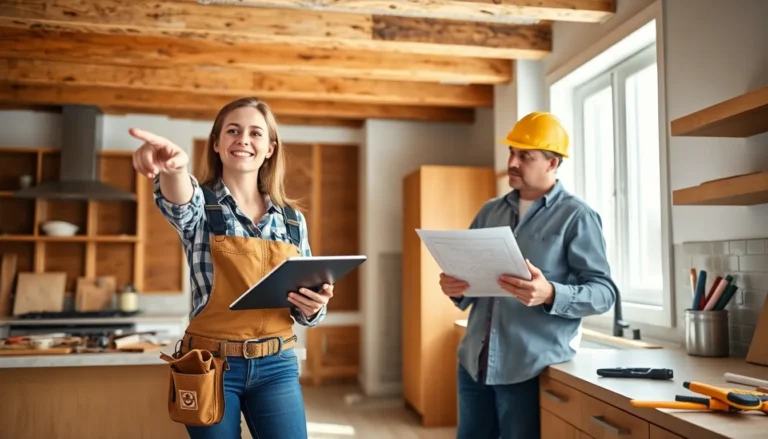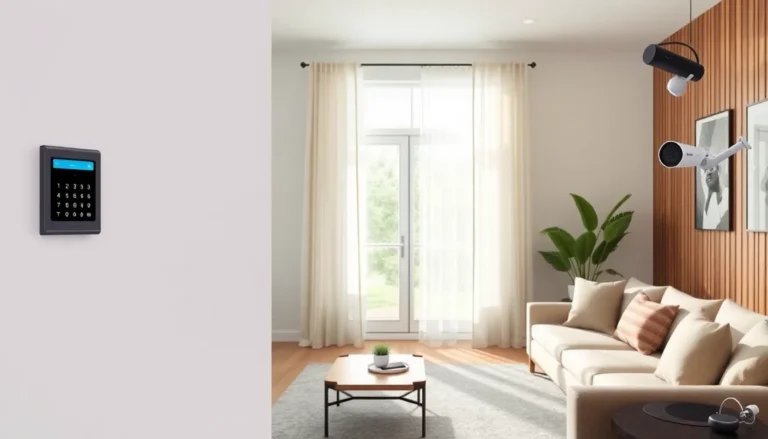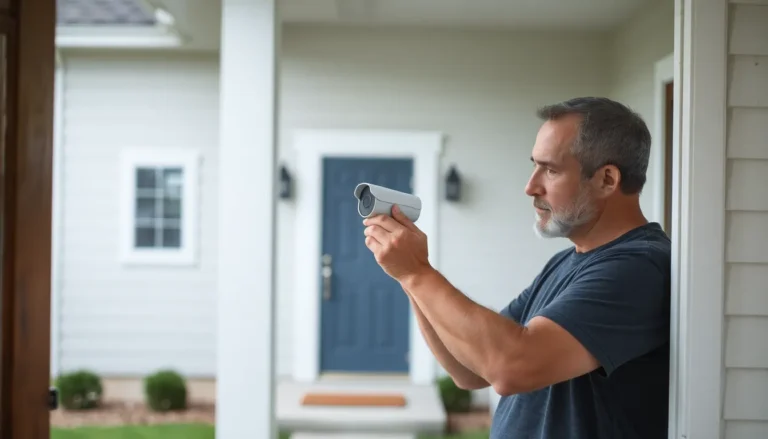In a world where the phrase “keeping up with the Joneses” has taken on a whole new meaning, luxury real estate trends are evolving faster than a cat meme goes viral. With buyers craving more than just square footage, the market’s heating up like a summer day in the Hamptons. From eco-friendly mansions to smart homes that practically run themselves, today’s luxury seekers are on the hunt for unique features that make a statement—preferably while sipping a fancy cocktail on their rooftop terrace.
As the demand for opulence grows, so do the trends that cater to the elite. Whether it’s wellness amenities that rival a five-star resort or spaces designed for remote work that don’t skimp on style, luxury real estate is becoming a playground for innovation. Buckle up as we dive into the latest trends that are shaping the high-end market and redefining what it means to live large.
Table of Contents
ToggleOverview of Luxury Real Estate Trends
The luxury real estate market reflects a significant shift in buyer preferences. Increasingly, individuals favor eco-friendly designs and sustainable materials in their homes. Smart home technology also stands out as a must-have feature, enabling homeowners to control various systems remotely and efficiently.
Unique outdoor spaces attract buyers looking for tranquility and leisure. Properties that integrate wellness amenities, like home gyms and spa-like bathrooms, draw particular interest. Stylish remote workspaces cater to the growing number of professionals working from home.
Market statistics show a rise in luxury home transactions, indicating heightened demand. High-end buyers increasingly prioritize properties in urban areas with access to cultural and recreational facilities. They often seek residences that embody exclusivity and sophistication.
Innovative design features play a crucial role in attracting interest. Elements like open floor plans and expansive windows create seamless indoor-outdoor experiences. Smart designs that encourage natural light and ventilation enhance comfort and ambiance.
Luxury developments now focus on community and connectivity. Gated communities or exclusive buildings offer security along with a sense of belonging. Buyers often value proximity to high-end dining, shopping, and entertainment options.
The evolving landscape of luxury real estate emphasizes lifestyle enhancements alongside traditional property values. Current market trends reflect a comprehensive approach to luxury living, integrating sustainability, technology, and wellness into desirable homes.
Current Market Dynamics

The luxury real estate market adapts rapidly to changing buyer preferences and economic factors. Significant demand and supply dynamics shape this environment.
Demand and Supply Factors
Sustainable materials attract buyers, fostering a market shift toward eco-friendly homes. Interest in smart home technology increases as buyers seek convenience and control. Unique outdoor spaces enhance property appeal, making homes with gardens or terraces highly sought after. Wellness amenities drive interest, with buyers prioritizing features like home gyms. Urban properties gain traction, drawing individuals who appreciate access to cultural amenities. The limited availability of luxury homes amplifies competition, pushing buyers to act quickly upon listings.
Price Movements and Forecasts
Prices in luxury real estate remain resilient amid economic fluctuations. Recent data shows price growth in metropolitan areas, particularly in cities with high demand. Buyers expect continued appreciation, especially for properties with modern amenities and design. Forecasts predict steady gains driven by limited inventory and strong buyer interest. Analysts emphasize the importance of location, suggesting properties in desirable neighborhoods will see higher value retention. The increasing focus on sustainability may enhance property values further, as buyers prioritize green features.
Influential Design Trends
Luxury real estate is embracing innovative design trends that meet modern buyers’ expectations for both style and functionality. Notable shifts focus on sustainability and technology.
Sustainable and Eco-Friendly Options
Sustainable materials attract discerning buyers seeking eco-friendly options. Properties featuring solar panels, energy-efficient windows, and sustainable landscaping show significant appeal. Buyers increasingly favor homes built with reclaimed wood, bamboo flooring, and recycled materials. Green certifications, such as LEED, add value and encourage environmentally conscious living. Outdoor spaces designed for native plants promote biodiversity while reducing water usage. These features not only enhance aesthetics but also contribute to healthier living environments.
Smart Home Technologies
Smart home technologies captivate prospective buyers with their convenience and efficiency. Integrated systems allow for remote control of lighting, security, and climate, catering to the modern lifestyle. Voice-activated assistants streamline daily routines and enhance accessibility throughout the home. Buyers appreciate properties equipped with security cameras, smart locks, and automated temperature control, ensuring safety and comfort. Additionally, energy management systems optimize resource consumption, appealing to sustainability-minded individuals. Ultimately, the integration of smart technologies revolutionizes luxury living, combining elegance with cutting-edge innovation.
Geographic Hotspots for Luxury Real Estate
Luxury real estate markets are expanding globally, driven by shifting buyer preferences and economic factors. Emerging and established markets show unique attributes that attract affluent buyers.
Emerging Markets
Asia’s luxury real estate scene has gained momentum, particularly in cities like Ho Chi Minh City and Bangkok. Urban innovations and a growing affluent class contribute to this trend. Buyers seek properties that reflect modern tastes and lifestyles, including features like smart home technology and green designs. Additionally, Latin America’s high-end markets, such as Mexico City and Bogotá, are growing due to increasing foreign investments. Properties in these locations often highlight cultural vibrancy, appealing to diverse clients. These emerging markets demonstrate a demand for luxury that aligns with evolving buyer expectations.
Established Luxury Markets
Established luxury markets, including New York City and Los Angeles, continue to lead with high demand. Iconic neighborhoods like Manhattan’s Upper East Side and Beverly Hills maintain their allure. Features in these cities focus on premium amenities, such as private concierge services and exceptional architectural designs. Buyers appreciate proximity to elite schools, exclusive restaurants, and cultural institutions. Additionally, factors like limited inventory keep prices strong in these areas. The market in Miami thrives with a blend of luxury and waterfront properties, alluring buyers seeking an upscale lifestyle. Each established market reinforces its status by delivering sought-after features and experiences.
Impact of Social and Economic Changes
Social and economic changes significantly influence the luxury real estate market. Increased focus on sustainability arises from growing environmental awareness among buyers, who prioritize eco-friendly features like solar panels and energy-efficient designs. Innovative technologies also reshape buyer expectations, with smart home systems gaining traction for their convenience and efficiency.
Urbanization drives demand for luxury properties near cultural and recreational amenities. Proximity to art galleries, theaters, and upscale dining enhances property values, catering to affluent buyers who seek vibrant lifestyles. Regional tourism also affects market dynamics; areas known for their attractions often see an uptick in luxury transactions.
Economic factors like low-interest rates and shifting employment trends boost luxury real estate activity. Employment stability encourages high-net-worth individuals to invest in premium properties. As remote work becomes commonplace, buyers increasingly aim for homes with dedicated workspaces, compounding existing demand for spacious layouts and wellness amenities.
Demographic shifts play a role in the changing landscape. Younger buyers now enter the luxury market, favoring modern designs and smart technologies in their homes. Increasingly, they look for unique outdoor spaces that promote relaxation and well-being.
Market conditions further define the luxury sector. Limited inventory amplifies competition, leading to consistent price resilience despite broader economic fluctuations. In desirable neighborhoods, property values continue to soar, reflecting strong buyer interest in exclusive, well-located homes. Additionally, the blend of sustainability and luxury aligns with evolving consumer preferences, reinforcing the trend toward high-end, eco-conscious living.
The luxury real estate market is undergoing a transformative phase that reflects changing buyer priorities. As sustainability and technology take center stage, properties that incorporate eco-friendly features and smart home systems are becoming increasingly sought after.
Buyers are not just looking for spacious homes but also for environments that promote wellness and connectivity. The rise of urban luxury living underscores a desire for convenience and access to cultural amenities.
As this sector continues to evolve, it’s clear that the integration of innovative design and lifestyle enhancements will shape the future of luxury real estate. The demand for unique, sustainable, and technologically advanced homes will likely remain strong, reinforcing the market’s resilience and adaptability.



